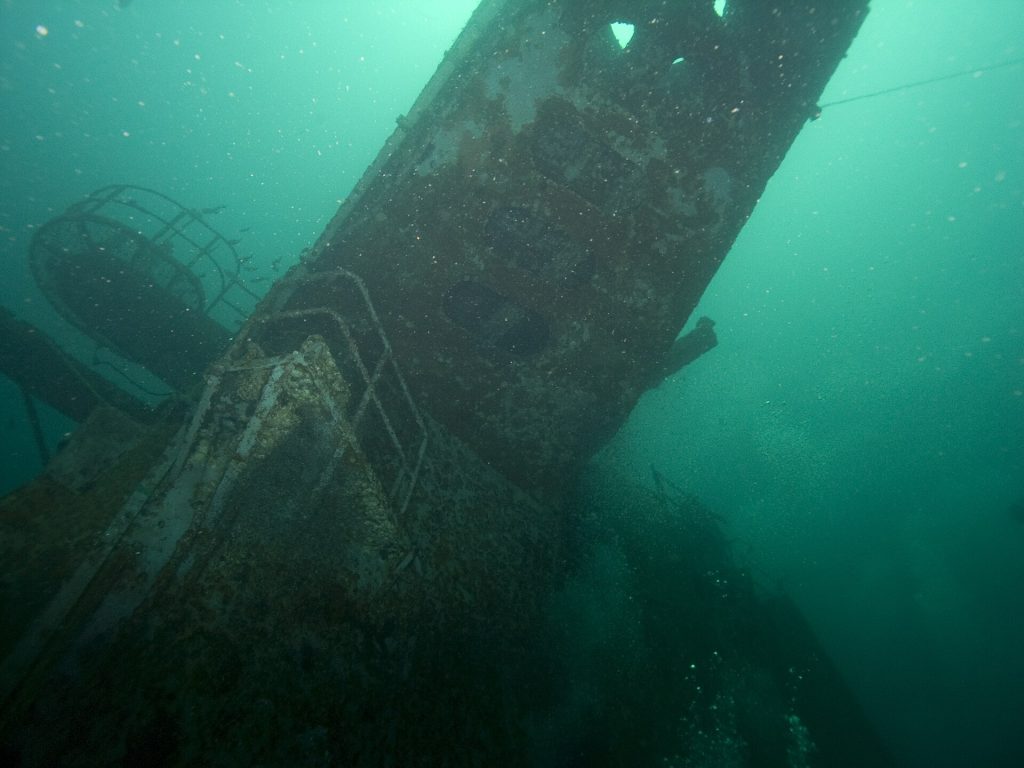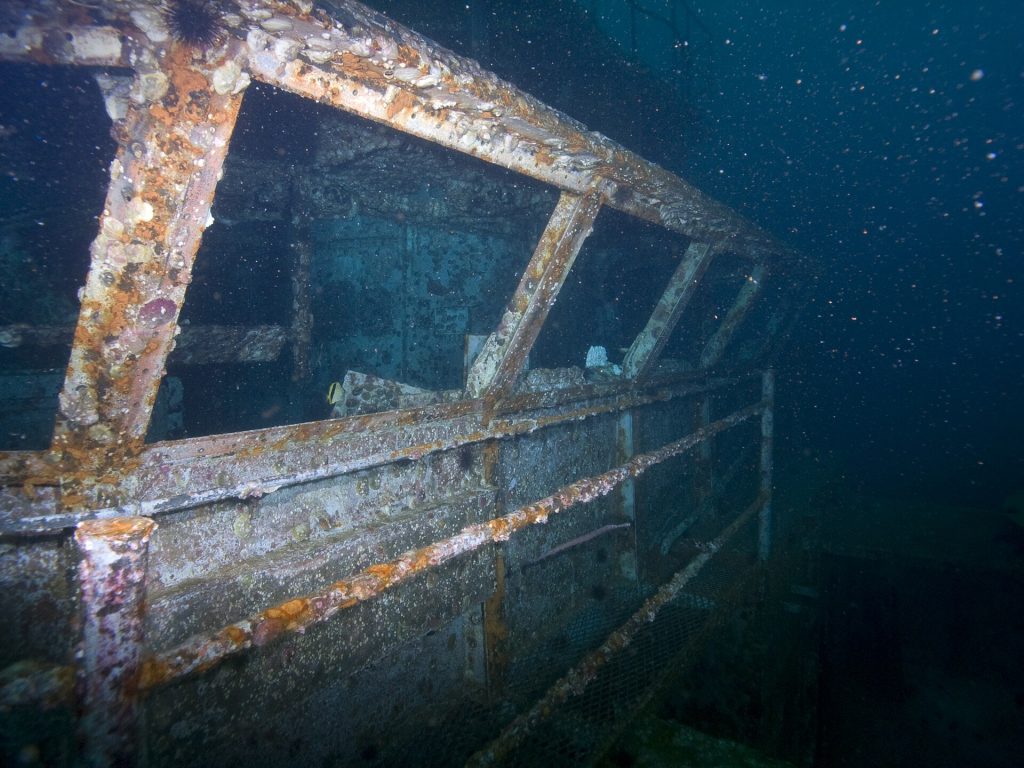The USS Oriskany (CV-34) was a prominent Essex-class aircraft carrier that served the U.S. Navy with distinction from its commissioning in 1950 through decommissioning in 1976.
Active during the Korean and Vietnam Wars, the ship played a pivotal role in naval air operations and underwent several significant events, including a tragic onboard fire in 1966.
In 2006, in a pioneering move, the decommissioned Oriskany was purposefully sunk off the coast of Florida, creating an artificial reef, where it now thrives as a marine sanctuary and popular dive site.
Construction Of USS Oriskany
The USS Oriskany, however, stood out even among its Essex-class siblings. Unlike the typical Essex-class design, the Oriskany boasted the “long-hull” or “Ticonderoga-class” design. This elongated hull gave the ship a distinctive edge, primarily allowing it to accommodate a more expansive flight deck. The significance of this adaptation cannot be understated.
As aviation technology rapidly evolved in the post-WWII era, naval aircraft began to demand more extended runways to facilitate jet-powered takeoffs and landings.
Oriskany’s modified design preemptively catered to this requirement, ensuring that the vessel would remain a viable platform for the newer generation of aircraft.
Construction of the USS Oriskany began with gusto in 1944 at the renowned New York Naval Shipyard. But as the tide of the Second World War turned, with Axis powers nearing defeat, the urgency of warship construction waned. This deceleration led to a hiatus in Oriskany’s construction shortly after the war’s end.
However, as the Cold War began to shape global geopolitics, the strategic importance of a robust naval force became evident once more.
 Launch of the USS Oriskany, October 13, 1945.
Launch of the USS Oriskany, October 13, 1945.
Recognizing the evolving dynamics of naval warfare, the U.S. Navy resumed Oriskany’s construction in 1947, infusing the carrier with updates to house and operate the latest aircraft. By 1950, the USS Oriskany was not just another ship added to the fleet; it was a modern marvel, epitomizing the fusion of design foresight and construction prowess.
Design
Dimensions
Displacement: At standard conditions, the Oriskany displaced approximately 27,100 tons. When fully loaded, this increased to around 40,600 tons.
Length: The overall length of the ship was 911 feet (277.7 meters), with a waterline length of 888 feet (270.7 meters).
Beam: The ship’s extreme width, inclusive of the flight deck, was 147.5 feet (45 meters). At the waterline, it measured 93 feet (28.3 meters).
Draft: In fully loaded conditions, the draft stood at about 28.7 feet (8.75 meters).
Propulsion and Speed The USS Oriskany was equipped with eight boilers that powered four Westinghouse geared steam turbines. These, in turn, operated four shafts, producing a total of 150,000 shp (110,000 kW). Such a powerful propulsion system enabled the ship to achieve speeds of approximately 33 knots (61 km/h; 38 mph).
Crew and Personnel The Oriskany had the capacity to accommodate a ship’s company of around 2,600 personnel. In addition to this, the air wing added another 2,100, which included aviators, ground crew, and support staff.
Armament and Defense Originally, the vessel’s armament consisted of four twin 5-inch (127 mm) 38-caliber guns, four single 5-inch (127 mm) 38-caliber guns, eight quadruple 40 mm 56-caliber guns, and 46 single 20 mm 78-caliber guns. To protect it from enemy fire, the Oriskany featured belt armor ranging from 2.5 to 4 inches (64 to 102 mm), a flight deck armor of 2 inches (51 mm), hangar deck armor of 1.5 inches (38 mm), and bulkheads that were 4 inches (102 mm) thick.
 USS Oriskany pictured here in 1966.
USS Oriskany pictured here in 1966.
Aircraft Capacity The aircraft-carrying capacity of the Oriskany was dynamic, influenced by the era and technological advancements in naval aviation. Depending on the period and aircraft type, the ship could house between 80 and 100 aircraft.
Operational History Of USS Oriskany
Korean War:
The USS Oriskany’s maiden combat deployment began soon after its commissioning, during the turbulent times of the Korean War. As the conflict between the North and South intensified, the ship was rapidly integrated into the U.S. Seventh Fleet operations in the Western Pacific. The aircraft embarked on the Oriskany were instrumental in providing air support for United Nations forces fighting on the Korean Peninsula.
The aircraft from its decks executed strategic bombing runs, reconnaissance missions, and combat air patrols, actively helping halt the advance of North Korean troops and their allies. Throughout this war, the Oriskany played a critical role, showcasing its potential as a mobile airbase that could project power and provide much-needed air support to ground forces.
Vietnam War:
It was, however, during the Vietnam War that the USS Oriskany truly showcased its resilience and importance. Over multiple deployments to the Gulf of Tonkin, the ship became one of the most active carriers in launching air operations against North Vietnamese targets.
As the U.S. escalated its involvement in the war, aircraft from the Oriskany flew thousands of sorties, ranging from bombing raids on infrastructure and military targets to providing close air support for ground troops.
 USS Oriskany during a deployment to Vietnam in 1967.
USS Oriskany during a deployment to Vietnam in 1967.
Yet, the ship’s Vietnam tours were not without challenges. The tragic fire in 1966 aboard the USS Oriskany remains one of the Navy’s deadliest accidents. An unintentional ignition of a magnesium flare led to an inferno that claimed the lives of 44 sailors and aircrew.
This event, although a dark chapter in its history, showcased the bravery and camaraderie of its crew. The recovery and the return to active duty after this tragedy was a testament to the ship’s importance and the spirit of its crew.
In the 1970s, as newer, more modern carriers joined the fleet, the USS Oriskany was redesignated as a training carrier.
How Did the Uss Oriskany Get Its Name?
The US Navy named the Oriskany after the August 6, 1777 battle in New York during their Revolutionary War. This aircraft carrier also earned the name ‘The Mighty O’. This nickname referred to its wide flight deck, its success in the Korean War, and the fact that it flew the most missions out of all US Navy carriers.
Transformation Into An Artificial Reef
After her decommissioning in 1976, the USS Oriskany, like many other decommissioned naval vessels, found herself in the U.S. Navy’s reserve fleet, colloquially referred to as the “mothball fleet.” During this period of inactivity, the Oriskany was meticulously maintained in a state of preservation, awaiting a potential recall to service or a final disposition decision.
Over the years, as newer naval vessels took precedence and the costs of maintaining older ships grew, it became apparent that a more permanent solution was required.
In the early 2000s, the idea of sinking retired vessels to form artificial reefs gained traction. The dual benefit was evident: it provided an environmentally-friendly method of disposing of old, large structures while simultaneously benefiting marine ecosystems by creating underwater habitats.
Such reefs would also stimulate local economies by attracting divers, researchers, and marine enthusiasts. The U.S. Navy and the Environmental Protection Agency started working in tandem to explore the potential of this idea. The USS Oriskany was identified as a suitable candidate for this project
USS Oriskany on her way to the Gulf Of Mexico to be sunk.
Transforming a former warship into a marine sanctuary is no easy task. It required extensive planning, especially in ensuring that the sinking would pose no environmental hazards. The Oriskany underwent rigorous cleaning and remediation processes.
Explosions on board the Oriskany.
Toxic substances, oils, and any potential pollutants were meticulously removed. Special attention was paid to ensure that the vessel, once sunk, would not only be safe for marine life but would also promote its growth and proliferation.

On May 17, 2006, the USS Oriskany began its final voyage. Off the coast of Pensacola, Florida, in the Gulf of Mexico, the ship was intentionally sunk, finding its resting place 212 feet below the surface. This operation was carefully controlled and monitored, ensuring the carrier settled upright on the ocean floor.
Within a short period, the Oriskany transformed from a steel giant into a thriving marine habitat. Coral colonies started forming on its surface, schools of fish navigated its vast decks, and the ship became a sanctuary for a multitude of marine species.
Gallery
The following are images taken at the wreck of the Oriskany, two years after her sinking.
 Image by Gareth Richards CC BY-SA 3.0
Image by Gareth Richards CC BY-SA 3.0
 Image by Gareth Richards CC BY-SA 3.0
Image by Gareth Richards CC BY-SA 3.0
 Image by Gareth Richards CC BY-SA 3.0
Image by Gareth Richards CC BY-SA 3.0
 Image by Gareth Richards CC BY-SA 3.0
Image by Gareth Richards CC BY-SA 3.0
 Image by Gareth Richards CC BY-SA 3.0
Image by Gareth Richards CC BY-SA 3.0
 Image by Gareth Richards CC BY-SA 3.0
Image by Gareth Richards CC BY-SA 3.0





